
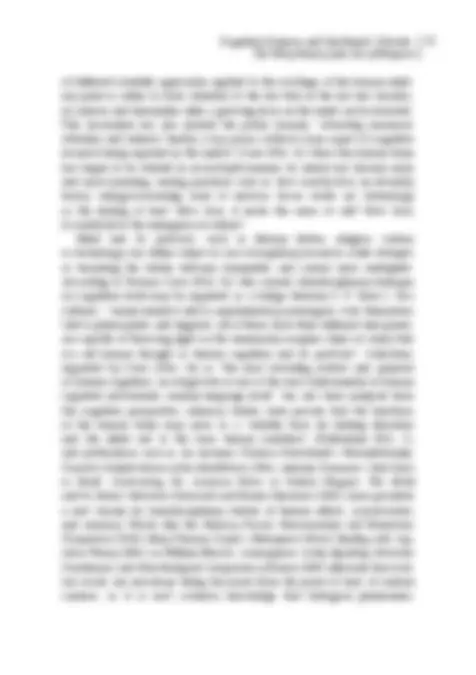
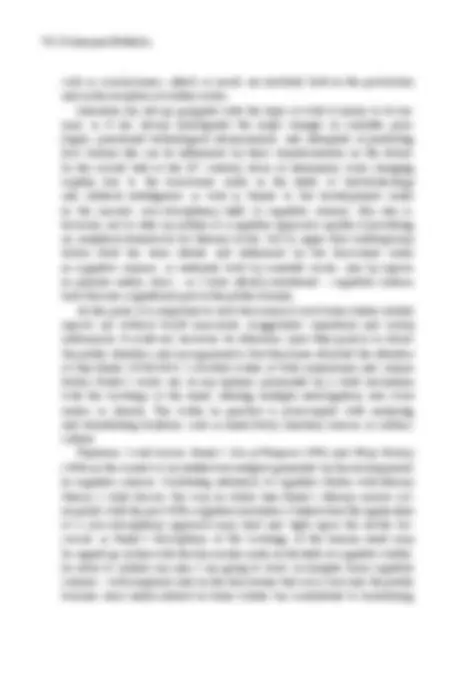
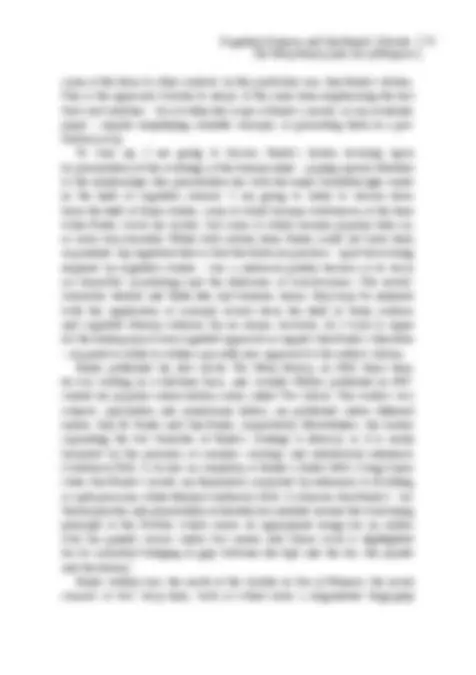

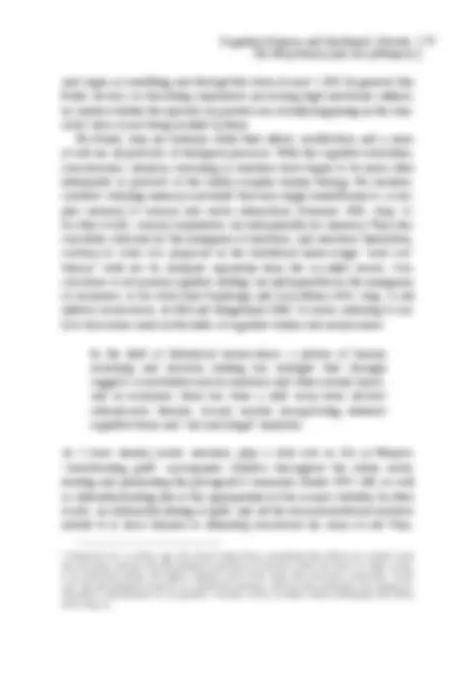
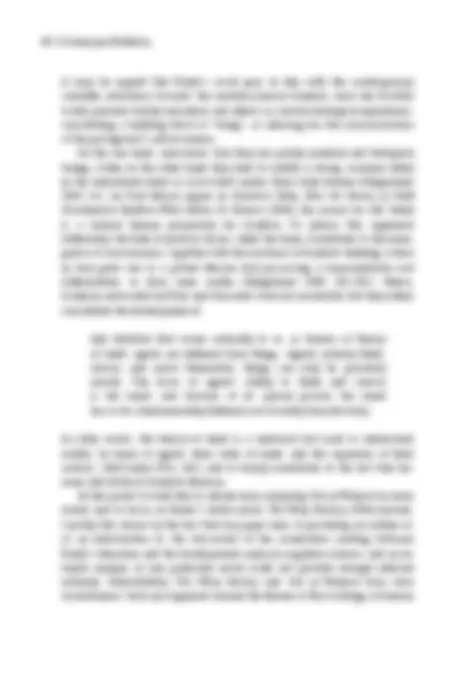
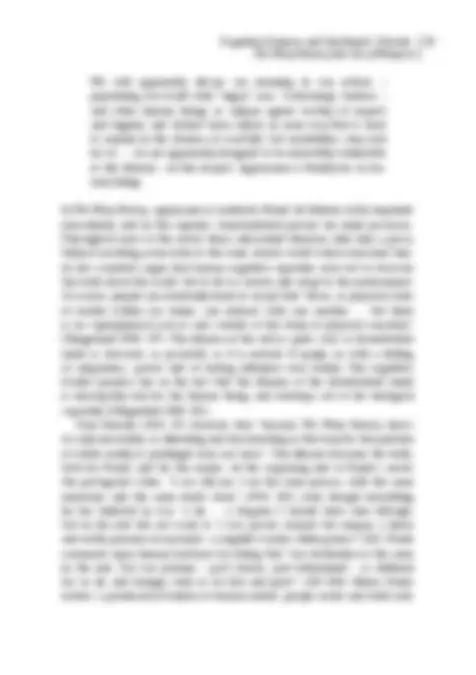
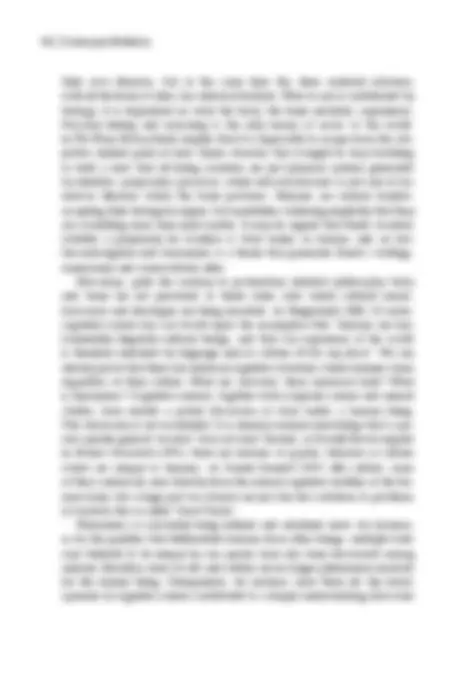
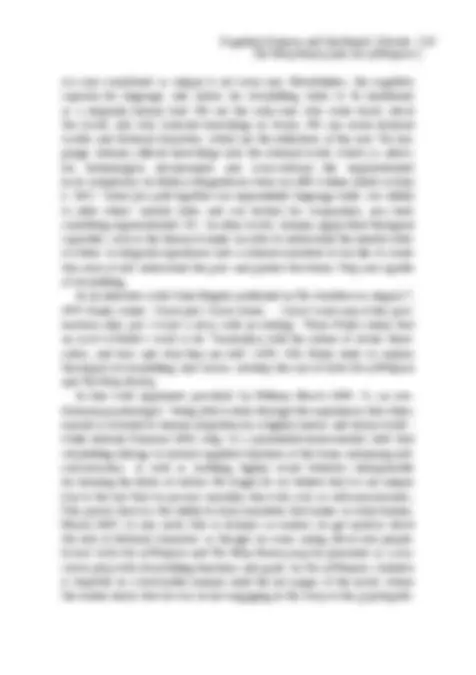



Study with the several resources on Docsity

Earn points by helping other students or get them with a premium plan


Prepare for your exams
Study with the several resources on Docsity

Earn points to download
Earn points by helping other students or get them with a premium plan
Community
Ask the community for help and clear up your study doubts
Discover the best universities in your country according to Docsity users
Free resources
Download our free guides on studying techniques, anxiety management strategies, and thesis advice from Docsity tutors
An insightful analysis of Iain Banks's Use of Weapons (1990) and Wasp Factory (1984) in the context of cognitive sciences. The essay discusses how these novels reflect the major breakthroughs in the field of cognitive sciences, focusing on the transformation of ideas about consciousness and humanness. The document also highlights the importance of collaboration between scientists and humanists in understanding human thought processes and cognition.
What you will learn
Typology: Study notes
1 / 18

This page cannot be seen from the preview
Don't miss anything!











Katarzyna Fetlińska “Cognitive Sciences and Iain Banks’s Novels: The Wasp Factory and Use of Weapons ”, Polish Journal of English Studies 2.1 (2016): 71–88.
Katarzyna Fetlińska University of Warsaw
Abstract: The aim of this paper is to discuss Iain Banks’s Use of Weapons (1990) and Wasp Fac tory (1984) in the context of the presentation of the workings of the human mind in both novels – paying special attention to the rela- tionships this presentation has with the major breakthroughs made in the field of cognitive sciences. Thus, I will provide a brief analysis of how the discov- eries made in cognitive sciences have transformed common ideas about con- sciousness and humanness. Subsequently, I shall analyse the way in which Iain Banks examines the workings of the human mind, as well as investigates the topic of humanness. In this essay I shall argue that Iain Banks’s novels are preoccupied with discussing and demolishing dualisms, such as mind/ body, emotions/reason, or nature/culture: this phenomenon is, according to me, likely to be correlated with the ideas popularised by the discoveries made in the field of cognitive sciences.
Key words: Iain Banks, cognitive sciences, mind, consciousness, dualism
The ideas concerning the indispensability of collaboration between scientists and humanists are not new: in 1959, Charles Percy Snow, a British scientist and novelist, published his famous lecture entitled The Two Cultures , in which he postulated that the 20th^ century is permeated by a deepening mutual incomprehension between scholars representing sciences and humanities.^1 According to Snow, the 20th^ century witnessed the spreading of the belief in the mismatch between materialist and biology-oriented worldview of sci- ence on the one hand, and the humanist investigations into socio-cultural
(^1) More in: Charles P. Snow, The Two Cultures , 1959 (London: Cambridge University Press, 2001).
72 Katarzyna Fetlińska
themes on the other. Nevertheless, the 1950s saw the rise of an intellectual movement, known nowadays as the cognitive sciences (Miller 2003, 141), which may be regarded as one of the reasons for the science–humanities dichotomy to be brought into question. The growing interest in the workings of the human mind was caused by developments in the nascent fields of neuroscience and computer science, the field of artificial intelligence included. George A. Miller (2003, 143), one of the founders of cognitive psychology, states that
by 1960 it was clear that something interdisciplinary was hap- pening … What you called it didn’t really matter until 1976, when the Alfred P. Sloan Foundation became interested. The Sloan Foundation had just completed a highly successful program of support for a new field called ‘neuroscience’ and two vice-presidents of the Foundation, Steve White and Al Singer, were thinking that the next step would be to bridge the gap between brain and mind. They needed some way to refer to this next step and they selected cognitive science.
Thus, the fascination with the brain, and the mind, has been growing. Due to advances in biology and computer science, the human nervous system could finally be studied in detail, and, in fact, the last decade of the 20th^ century was dubbed the Decade of the Brain (Nalbantian 2011, 3). Developments in research on brain functions have been capacitated by sophisticated technologies; cognitive psychologists are engaging in studies and experiments designed to elucidate and reassess the intricacies of human thought processes, philosophers are focusing on the matters of cognition, while anthropologists are making attempts at explaining the evolution of cognitive capacities (Cave 2016, 12). In other words, grand developments in cognitive sciences led to the rise of various novel approaches applied to explaining human behavior, such as cognitive psychology, neuroscience, or evolutionary psychology. In the study of the human mind and its products, the borders dividing the scientific and humanistic disciplines became blurred. Already in the 1970s, Miller argued that in cognitive science “at least six disciplines were involved: psychology, linguistics, neuroscience, computer science, anthropology and philosophy” (2003, 143). I shall not delve, however, into the investigation
74 Katarzyna Fetlińska
such as consciousness, affects or recall, are involved both in the production and in the reception of written works. Literature has always grappled with the topic of what it means to be hu- man, as it has always investigated the major changes in scientific para- digms, questioned technological advancements, and attempted at predicting how human life can be influenced by these transformations in the future. In the second half of the 20th^ century, ideas of humanness were changing rapidly due to the discoveries made in the fields of bio(techno)logy and artificial intelligences as well as thanks to the developments made in the nascent, cross-disciplinary field of cognitive sciences. My aim is, however, not to offer an outline of a cognitive approach capable of providing an analytical framework for literary works, but to argue that contemporary fiction itself has been altered and influenced by the discoveries made in cognitive sciences, as mediated both by scientific works, and by reports in popular media, since – as I have already mentioned – cognitive sciences have become a significant part of the public domain. At this point, it is important to note that many of such brain studies related reports are without doubt inaccurate, exaggerated, superficial and overly enthusiastic. It could not, however, be otherwise, since their point is to attract the public attention; and my argument is that they have attracted the attention of Iain Banks (1954–2013): a Scottish writer of both mainstream and science fiction. Banks’s works are, in my opinion, permeated by a vivid fascination with the workings of the mind, offering multiple investigations into what makes us human. The writer in question is preoccupied with analysing and demolishing dualisms, such as mind/body, emotions/reason, or nature/ culture. Therefore, I will discuss Banks’s Use of Weapons (1990) and Wasp Fac tory (1984) in the context of an intellectual zeitgeist generated by the developments in cognitive sciences. Combining references to cognitive studies with literary theory, I shall discuss the way in which Iain Banks’s literary oeuvre cor- responds with the post-1950s cognitive revolution. I believe that the application of a cross-disciplinary approach may shed new light upon the novels dis- cussed, as Banks’s descriptions of the workings of the human mind may be argued go in line with the discoveries made in the field of cognitive studies. In order to achieve my aim, I am going to draw on insights from cognitive sciences – with emphasis laid on the discoveries that cross over into the public domain, since media interest in brain studies has contributed to transferring
Cognitive Sciences and Iain Banks’s Novels: The Wasp Factory and Use of Weapons
some of the ideas to other contexts: in this particular case, Iain Banks’s fiction. This is the approach I decide to adopt, at the same time emphasising the fact that such transfers – be it within the scope of Banks’s novels, or my academic paper – require simplifying scientific concepts, or presenting them in a per- functory way. To sum up, I am going to discuss Banks’s fiction focusing upon its presentation of the workings of the human mind – paying special attention to the relationships this presentation has with the major breakthroughs made in the field of cognitive sciences. I am going to relate to chosen ideas from the field of brain studies, some of which became well-known at the time when Banks wrote his novels, but some of which became popular later on, or even very recently. While with certain ideas Banks could not have been acquainted, my argument here is that the fiction in question – apart from being inspired by cognitive studies – has a universal quality because of its focus on characters’ psychology and the intricacies of consciousness. The novels’ characters behave and think like real humans; hence, they may be analysed with the application of concepts drawn from the field of brain sciences and cognitive literary criticism. By no means, however, do I wish to argue for the inadequacy of non-cognitive approach as regards Iain Banks’s literature
Cognitive Sciences and Iain Banks’s Novels: The Wasp Factory and Use of Weapons
One of the dualisms well established in culture is the mind/body dualism, which implies that the body equals physical matter while the mind does not. Even though mind and body have been already driven apart by Plato or St. Paul, it is Descartes who dignified the dualism in question by depriving the mind of any physical features. For centuries, a breach had existed between matter and idea, as well as between mind and material substrate. However, as the studies of consciousness have been brought into a biological context, the mind/body problem, otherwise known as substance dualism, gradually dispersed: cognitive sciences provided a counterbalance to the long-established prevalence of a traditional rationalist idea of the body as a container for the in- dependent mind, as well as offered an alternative to the postmodernist view that the body can be compared to a blank slate to be culturally inscribed by disembodied discourses. Consciousness is no longer an ontologically distinct substance, “but rather an emergent property of matter put together in a sufficiently complicated way” ( Slingerland 2008, 10). While according to ‘first generation’ cognitivist studies the human mind could be likened to a computer, or a thinking machine, “current ‘second-generation’ approaches insist … on the continuity between body and mind (Cave 2016, 28). In other words, it has become clear that the mind and its sense of self are the products of processes happening in the material body. These concepts are, in my opin- ion, present in Banks’s Use of Weapons , where a drone tells Zakalwe that his “brain is made up of matter” and “organised into information-handling, processing and storage units” by genes and biochemistry (1992, 256). To Banks, the human brain equals pure materiality, out of which grow all the ideas we possess about the self and the world we are immersed in. Consciousness is not reserved for biological organisms. In order for it to exist, one primary condition has to be fulfilled: matter has to reach a sufficient level of complexity. Therefore, in Use of Weapons Banks presents a universe populated by various machines capable of thinking, feeling, and originating creative ideas: the reader comes across multiple sentient drones, intelligent pieces of armor, or super- advanced computers called the Minds. As one of the drones notes: a com- puter’s mind is very similar to the human mind, since it “is also made up of matter, but organised differently” (256). Banks’s fiction undoubtedly exhibits a preoccupation with the idea of consciousness arising from matter, and not understood as an outcome of possessing some inherent, immaterial substance.
78 Katarzyna Fetlińska
I believe that Banks’s preoccupation with materiality and substance monism can be associated with the influence the cognitive revolution had on culture. Humans, as presented in the Use of Weapons , are heavily body-oriented, and they tend to value pleasures of the flesh: thanks to “genofixing” they can live virtually forever, producing pleasure-inciting and pleasure-enhancing drugs in their bodies, and being able to commit most of their time to joy- ful activities, such as travelling, games, sports or sex. Therefore, the Cul- ture’s citizens could be described as exponents of hedonistic philosophy. In one of the descriptions Banks states:
Their machines could do everything else much better than they could; no sense in breeding super-humans for strength or intel- ligence, when their drones and Minds were so much more matter- and energy-efficient at both. But pleasure... well, that was a dif- ferent matter. What else was the human form good for? (260)
The writer often provides detailed descriptions of visceral and emotional experiences of his characters, and in Use of Weapons one of the Culture’s drones states that “sensory stimulation”, which equals “feeling touching, tasting, smelling, hearing, and seeing”, allows for the emergence of sentience (256). At the same time, the most critical moments in Zakalwe’s life are all related to feelings, experienced simultaneously on sensory and psychological levels:
He tried to remember the garden and the smell of flowers, the way he sometimes did whenever the fighting started to seem just too futile and cruel to have any point whatsoever, but for once he could not conjure up that faintly-remembered, beguilingly poignant perfume, or recall anything good that had come out of that garden (instead he saw again those sun-tanned hands on his sister’s pale hips, the ridiculous little chair … and he’d wanted to weep and scream and tear it all down with his own hands …) (338–339).
In fact, events rich in emotional content pertain “sharp and fresh” in Zakalwe’s memory, regardless of how many years have passed. Non- emotionally charged events, however serious they might be, become “dim
80 Katarzyna Fetlińska
it may be argued that Banks’s work goes in line with the contemporary scientific reluctance towards the emotion/reason dualism, since the Scottish writer presents bodily sensations and affects as crucial ontological experiences, constituting a building block of “being”, or allowing for the (re)construction of the protagonist’s self-awareness. On the one hand, men know that they are purely material and biological beings, while on the other hand they tend to exhibit a strong, common belief in the immaterial mind or soul which makes them truly human (Slingerland 2008, 26). As Paul Bloom argues in Descartes’ Baby: How the Science of Child Development Explains What Makes Us Human (2004), the reason for this belief is a natural human propensity for dualism. To phrase this argument differently: the bulk of nervous tissue, called the brain, contributes to the emer- gence of consciousness, together with the existence of dualistic thinking, which in turn gives rise to a potent illusion that possessing a transcendental soul differentiates us from mere matter (Slingerland 2008, 281–282). Hence, dualisms advocated by Plato and Descartes were not accidental, but they rather constituted the development of
[a]n intuition that comes naturally to us, as bearers of theory of mind: agents are different from things. Agents actively think, choose, and move themselves; things can only be passively moved. The locus of agents’ ability to think and choose is the mind, and because of its special powers the mind has to be a fundamentally different sort of entity than the body.
In other words, the theory of mind is a universal tool used to understand reality “in terms of agents, their states of mind, and the sequences of their actions” (McCauley 2011, 185), and it clearly contributes to the fact that hu- mans fall victim to dualistic illusions. At this point I would like to refrain from analysing Use of Weapons in more detail, and to focus on Banks’s debut novel, The Wasp Factory (1984) instead. I justify this choice by the fact that my paper aims at providing an outline of, or an introduction to, the discussion of the connections existing between Banks’s literature and the developments made in cognitive sciences, and an in- depth analysis of one particular novel could not provide enough relevant material. Undoubtedly, The Wasp Factory and Use of Weapons bear close resemblances: both are organised around the themes of the workings of human
Cognitive Sciences and Iain Banks’s Novels: The Wasp Factory and Use of Weapons
mind and the emergence of consciousness, both offer the stories of characters constructing their personal narratives, and both investigate the topic of du- alisms. Nevertheless, I assume that The Wasp Factory may serve as a good exemplification of Banks’s views concerning the general human propensity for dualist thinking, complementing the discussion of Use of Weapons , and thus constituting a useful illustration of the possible relationships between literature and the cognitive sciences. The Wasp Factory is narrated by Frank Cauldhame, a teenager living on a secluded island together with his father, Angus. At the beginning of the story, Frank discovers that his insane brother, Eric, has escaped from the asylum and is now on his way home. Anticipating Eric’s imminent arrival, the reader gradually gets acquainted with the story of the main protagonist: in early childhood, Frank has been attacked by a dog, which has bitten off the boy’s genitals, leaving him forever impaired. Frank possesses no birth certificate and is subject to home-schooling, so he spends most of his time on the island: blasting things (and animals) with self-made bombs, hunting, drinking alcohol, and attempting to make telepathic contact with Eric. Most importantly, Frank is the creator of the Wasp Factory: a complex device comprising of an old clock-face equipped with twelve branching cor- ridors, and used in order to predict the future. Frank places wasps in the Wasp Factory: depending on which corridor the wasp chooses, it dies in a different manner (be it, for instance, drowned, consumed by fire, or eaten by a spider). Frank regards the wasps’ deaths as prophecies relating to his, and his rel- ative’s, existence. As the novel progresses, the reader learns the truth about the main protagonist: surprisingly, he is a not an adolescent boy, but a girl. The story about the dog’s attack was invented by Angus, a mad scientist who subjected his daughter Francis to chemical treatment in order to make her male. Angus hated women, and he made Francis/Frank hate them too: as a consequence, the teenager strongly believed in an illusion of boyhood. Now that I have provided a brief summary of the story, I shall discuss the way Banks refers to the topic of dualistic thinking in The Wasp Factory.^3 As I have already mentioned, the novel is set in the confined space of a small, secluded island, which offers almost laboratory-like conditions to observe
(^3) Banks’s obsession with doubleness has been noticed by Paul Kincaid, who observes that “every member of the Cauldhame family seems to be both damaged and doubled” (2013, 29). Frank has his mirror in Eric, Angus in his ex-wife, Agnes, and Frank’s little cousin Paul in the family dog, Saul.
Cognitive Sciences and Iain Banks’s Novels: The Wasp Factory and Use of Weapons
We will apparently always see meaning in our actions – populating our world with “angry” seas, “welcoming” harbors – and other human beings as unique agents worthy of respect and dignity, and distinct from objects in some way that is hard to explain in the absence of soul-talk, but nonetheless very real for us … we are apparently designed to be irresistibly vulnerable to this illusion – in this respect, Appearance is Reality for us hu- man beings.
In The Wasp Factory , appearance is reality for Frank: he believes in his impaired masculinity, and in the superior, transcendental powers his mind possesses. Throughout most of the novel, these self-created illusions offer him a possi- bility of ascribing some order to the cruel, chaotic world which surrounds him. In fact, scientists argue that human cognitive capacities exist not to discover the truth about the world, but to let us survive and adapt to the environment. Of course, people can eventually learn to accept that “ideas, as physical states of matter within our brains, can interact with one another … but there is no superphysical soul or self, outside of the chain of physical causation” (Slingerland 2008, 257). The illusion of the self as spirit, soul, or disembodied mind is, however, as powerful, as it is natural. It equips us with a feeling of uniqueness, power and of having influence over reality. The cognitive, dualist paradox lies in the fact that the illusion of the disembodied mind is inescapably real for the human being, and develops out of his biological capacities (Slingerland 2008, 281). Paul Kincaid (2013, 35) observes that “because The Wasp Factory shows us only one reality, as alienating and disconcerting as that may be, the question of which reality is privileged does not arise”. The illusion becomes the truth, both for Frank, and for the reader. At the surprising end of Banks’s novel, the protagonist states: “I am still me; I am the same person, with the same memories and the same deeds done” (1998, 183), even though everything he has believed in was “a lie … a disguise I should have seen through, but in the end did not want to. I was proud; eunuch but unique; a fierce and noble presence in my lands, a crippled warrior, fallen prince” (183). Frank comments upon human existence by stating that “our destination is the same in the end, but our journey – part chosen, part determined – is different for us all, and changes even as we live and grow” (183–184). Hence, Banks notices a paradoxical dualism of human nature: people create and delve into
84 Katarzyna Fetlińska
their own illusions, but at the same time the sheer material existence, with all the forms it takes, has universal features. Who we are is conditioned by biology: it is dependent on what the body, the brain included, experiences. Personal feeling and reasoning is the only means of access to the world: in The Wasp Factory Banks implies that it is impossible to escape from the sub- jective, limited point of view. Banks observes that it might be very troubling to hold a view that all living creatures are just physical systems generated by mindless, purposeless processes, while self-consciousness is just one of nu- merous illusions which the brain produces. Humans are natural dualists, accepting their biological origins, but nonetheless believing implicitly that they are something more than mere matter. It may be argued that Banks wonders whether a propensity for dualism is what makes us human: and, in fact, the investigation into humanness is a theme that permeates Banks’s writings, mainstream and science-fiction alike. Nowadays, quite the contrary to postmodern relativist philosophy, body and brain are not perceived as blank slates onto which cultural norms, discourses and ideologies are being inscribed. As Slingerland (2008, 15) notes, cognitive science has cast doubt upon the assumption that “humans are fun- damentally linguistic-cultural beings, and that our experience of the world is therefore mediated by language and/or culture all the way down ”. We can already prove that there are universal cognitive structures which humans share regardless of their culture. What are, however, these universal traits? What is humanness? Cognitive sciences, together with computer science and animal studies, have incited a potent discussion of what makes a human being. This discussion is not essentialist: it is already common knowledge that a spe- cies-specific general “essence” does not exist. Instead, as Donald Brown argued in Human Universals (1991), there are features of psyche, behavior or culture which are unique to humans. As Daniel Dennett (1995, 486) added, some of these universals arise directly from the natural cognitive facilities of the hu- man brain, but a huge part we observe are just the best solutions to problems of survival: the so-called “Good Tricks”. Humanness is constantly being defined and redefined anew: for instance, as for the qualities that differentiate humans from other beings, multiple traits once believed to be unique for our species have also been discovered among animals. Morality, sense of self, and culture are no longer phenomena reserved for the human being. Chimpanzees, for instance, have them all: the devel- opments in cognitive science contributed to a deeper understanding that what
86 Katarzyna Fetlińska
like Elethiomel, who remodeled his memories in order to compile a positive image of himself. In The Wasp Factory , Frank glues various (often disconnected) events from his, Angus’s and Eric’s life, as well as things of mere chance hap- pening on the island, into a concise narrative. Like Zakalwe, Frank creates his own self-serving fiction. Hence, Banks appears also to be intent on accus- toming the reader with the power of storytelling: he makes the protagonists’ highly improbable narratives absolutely real and plausible, and this is why the truths discovered at each novel’s end are so surprising. Since it may be ar- gued that Banks treats literature as an analysis of humanness, while believing that humanness is closely related to the phenomenon of storytelling, it may also be postulated that the Banks presents and treats his characters as real people, subjecting them to the discussion of what it means to be human. Banks is aware of the impact narratives have on the reader’s mind: meaning the reader’s engagement, and his propensity to forget about the fictional aspect of literature. The emergence of language, together with the ability to narrate, is closely related with superior social skills that people possess. Due to their biological capacities, humans can accumulate information and transmit knowledge in narratives, which allows for the existence of cultural life unprecedented in its complexity. I think it is crucial to note here that among scientists the nature/culture dualism has becomes invalid, since, as Antonio Damasio (2010, chap. 11) observes, “biology and culture are thoroughly interactive”, and culture may be termed as a “biological revolution”. What this means, however, is not that all culture’s products share a natural origin, but that the emergence and existence of culture itself is capacitated by the powers of human biology. Banks seems to share this view: in his varied and multiple writings, Banks was preoccupied with examining, among other things, how we create consciousness, what makes us human, and what is the sub- sequent connection between human biology and the emergence of culture. Since this topic is very broad, in this essay I have limited myself to offering a concise outline of, or an introduction to, the discussion of the relationships between cognitive sciences and Banks’s literary oeuvre.
Cognitive Sciences and Iain Banks’s Novels: The Wasp Factory and Use of Weapons
Works Cited
Banks, Iain. 1984. The Wasp Factory. Repr., New York: Simon & Schuster Paperbacks, 1998. Banks, Iain M. 1990. Use Of Weapons. Repr., London: Orbit, 1992. Cave, Terence. 2016. Thinking with Literature: Towards a Cognitive Criticism. Oxford: Oxford University Press. Colebrook, Martyn. 2010. “Reading Double, Writing Double: The Fiction of Iain (M.) Banks”. The Bottle Imp 8: 1–6. Damasio, Antonio. 2010. Self Comes to Mind: Constructing the Conscious Brain. New York: Pantheon. E-Pub. Dennet, Daniel. 1995. Darwin’s Dangerous Idea: Evolution and the Meaning of Life. New York: Simon & Schuster. Flesch, William. 2009. Comeuppance: Costly Signaling, Altruistic Punishment, and Other Biological Components of Fiction. Cambridge and London: Harvard University Press. Kincaid, Paul. 2013. “Far Too Strange: The Early Fiction of Iain Banks”. Foundation 42.116: 23–36. McCauley, N. Robert. 2011. Why Religion Is Natural and Science Is Not. New York: Oxford University Press. Middleton, Tim. 1995. “Constructing the Contemporary Self: The Works of Iain Banks.” In Contemporary Writing and National Identity , edited by Tracy Hill and William Hughes, 18–28. Bath: Sulis Press. Miller, A. George. 2003. “The Cognitive Revolution: A Historical Perspective.” Trends in Cognitive Sciences 7: 141–144. Nairn, Thom. 1993. “Iain Banks and the Fiction Factory.” In The Scottish Novel since the Seventies: New Visions, Old Dreams , edited by Randall Stevenson and Gavin Wallace, 127–135. Edinburgh: Edinburgh University Press. Nalbantian, Suzanne. 2011. Introduction to The Memory Process: Neuroscientific and Humanistic Perspectives edited by Suzanne Nalbantian, Paul M. Matthews, and James L. McClelland, 1–26. Cambridge and London: MIT Press. Panksepp, Jaak, and Lucy Biven. 2012. The Archaeology of Mind: Neuro- evolutionary Origins of Human Emotions. New York: W. W. Norton.